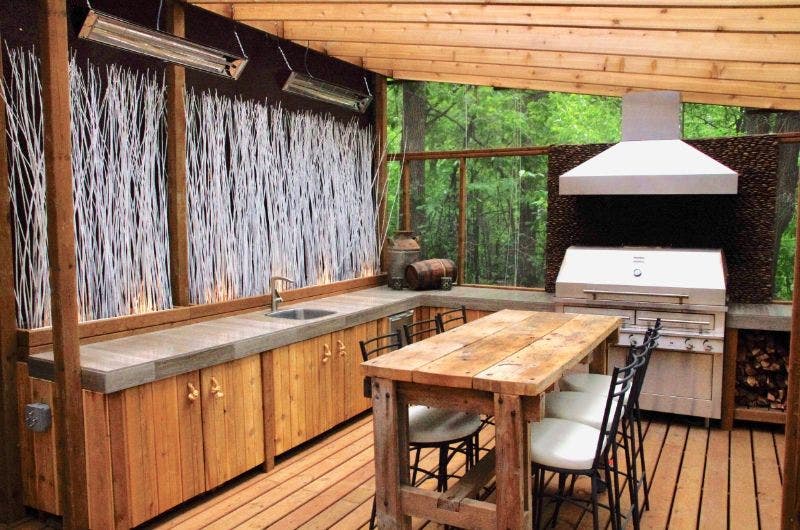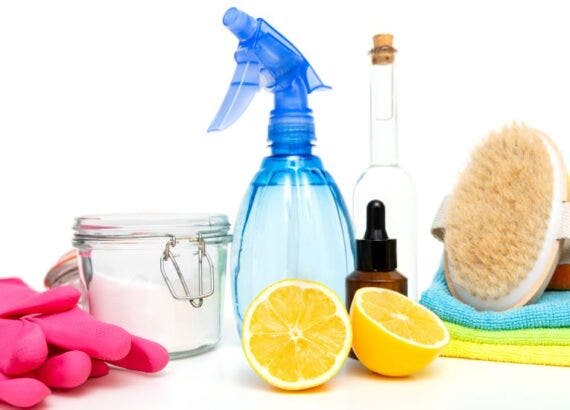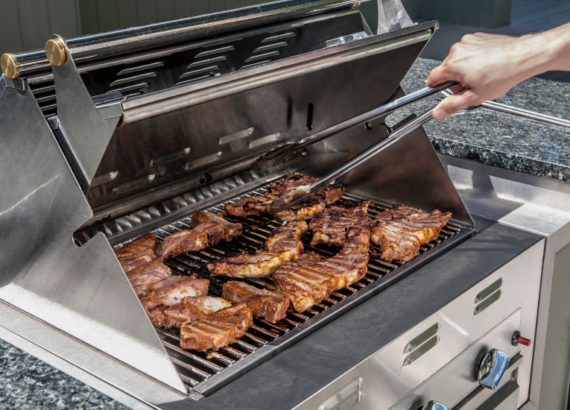15 Tips for Treating Outdoor Wood

Treating outdoor wood isn’t rocket science. But if you haven’t done it before, it can be daunting. We’ll go over 15 tips for treating outdoor wood. They’ll help you apply a smooth even finish that will last for years to come.
For our step-by-step guide on how to treat wood for outdoor use, check out this article.
Table of Contents
Apply your finish with the grain.
Whenever you paint or apply finish to wood, it’s always best to go with the grain. All wood has a natural direction of the wood fibers. Just look closely to figure out which direction it is.
Brushing against the grain helps the finish look smooth and absorb into the wood evenly. If you brush against the grain, you might end up with visible brush strokes. The finish won’t look uniform.
End grain is more porous so it may require more coats.
If you haven’t heard of end grain, it is the wood on the end of tables. It has a rougher texture than the tabletop surface. If the end grain is not sealed properly, it’ll absorb moisture and stains more readily. If you don’t use enough finish, it may look discolored.
Here’s one strategy to ensure finish seeps deep into the pores of your end grain wood.
Dilute your finish with water for water-based sealants or mineral spirits for oil-based sealants.
Most finishes are quite thick right out of the can, so it’s important to dilute them before applying. Water and oil do not mix, so make sure you dilute your sealant with the right solution. Besides mineral spirits, turpentine and acetone work well to dilute oil-based sealants.
Three to four parts sealant to one part of the diluting solution. With some finishes, you can dilute them half and half, or a 1:1 ratio.
Paint your finish rather than spray for the best results.
Spraying finish is faster than brushing and it’s easy to apply even coats. But it requires a LOT of coats and doesn’t absorb deeply into the wood. For the finish to last, it should soak fully into the wood. Especially if the wood is not porous, brushing is highly recommended.
Don’t overload the brush.
Overloading the brush causes drips and can contribute to an uneven coating. Not to mention it can just be a mess. Instead, dip the brush about halfway into the finish.
Your brush won’t last as long if paint soaks deep into the bristles. They’ll break apart over time.
Clean your brush between uses.
Maintaining your brush is key to applying a smooth finish. When wet paint dries on a brush, it can be very difficult to clean. The bristles may break or wear down faster if you don’t clean your brush after every use.
Make sure you have adequate ventilation before applying sealant.
Wood finishes, particularly oil-based sealants, can have a strong smell. Oil-based sealants contain VOCs which are harmful if inhaled in high quantities. Finish your wood furniture outside if possible. If you’re inside, open windows and doors while applying the finish.
Mix the finish thoroughly, but do not shake or aggressively stir the finish.
Shaking the finish can create air bubbles that would remain on the surface, even after the sealant dries.
Let the wood dry before applying finish. Make sure the finish is dry before applying additional coats.
The wood will more readily absorb the finish if it’s dry. If part of the wood is wet, it will absorb less finish so you won’t get an even coat. Let the finish dry between coats so that you can apply it evenly.
Clean and sand the wood before applying your coat.
You want to remove all dirt and debris from the wood before giving it a light sand. Take a damp rag and wipe the wood off. Let it dry then lightly sand the wood. Now you’re ready to apply the finish!
Remove the old stain before applying new stain.
If you’re applying the same stain, you don’t need to remove it. But it might be a good idea if the old stain was applied unevenly or looks unprofessional. If you’re changing colors or using a different stain altogether, remove the old stain first. Otherwise it will show through and look sloppy.
Use epoxy to fill cracks.
Some epoxy resins work well at filling in cracks in wood as the resin seeps into the hard-to-reach areas with ease. Not all epoxies are thin enough to do that, though.
Here’s a quick clip showing you how epoxy can be effective at filling in cracks.
The more coats you have, the finer sandpaper you should use.
It’s best practice to use at least 120 grit sandpaper to prepare your wood for finishing. The higher the number, the finer the sandpaper. As you apply coats, use finer sandpaper like 220 or 320 grit. Fine sandpaper is gentler on the finish which is needed when you have applied several coats. If you use a sandpaper that’s too coarse, it may remove some of the finish and cause future coats to be uneven.
Cover the finished furniture while it dries.
Inclement weather can ruin a project overnight. It doesn’t take much rain or snow. You don’t want your furniture to get rained on as it will wear down some of the finish.
After you’ve applied oil-based sealant, place any oily rags in water.
As the oil dries, it generates heat and the rag can spontaneously combust. After it soaks in water for a few minutes, ring out the rag and let it dry before throwing it out. Do not reuse oily rags.
Frequently Asked Questions
Can you use vegetable oil to preserve wood?
It’s not recommended to use vegetable oil to preserve wood. Drying oils like linseed or tung oil are best. They take much longer to go rancid.
Can you use olive oil to protect wood?
Olive oil is not the best option to protect wood. Drying oils like linseed or tung oil work much better. They are more durable and take much longer to go rancid.
Can you paint wood to make it waterproof?
Not all paint makes wood waterproof but it will increase water resistance. To waterproof wood, you can use a waterproof paint, water-based sealant or oil-based sealant. Linseed and tung oil are great options.
How do you keep wood from rotting outside?
You can apply boric acid to wood to protect your wood from rot. In outdoor environments, look for pressure-treated lumber that is much more durable than standard wood. For outdoor furniture, apply a varnish or polyurethane to keep the wood in good condition.
Does wood stop rotting when dry?
There are two types of wood rot: dry rot and wet rot. Dry rot is a different type of fungi than wet rot that continues to break down the wood after it’s dried. Wet rot requires moisture to flourish.
We hope these tips helped you apply the perfect outdoor finish. For more outdoor content, check out the articles below!
Related Articles
How to Treat Wood for Outdoor Use
How to Make Outdoor Furniture Last
How to Clean Outdoor Furniture (Complete Guide)
Can you use vegetable oil to preserve wood?
It’s not recommended to use vegetable oil to preserve wood. Drying oils like linseed or tung oil are best. They take much longer to go rancid.
Can you use olive oil to protect wood?
Olive oil is not the best option to protect wood. Drying oils like linseed or tung oil work much better. They are more durable and take much longer to go rancid.
Can you paint wood to make it waterproof?
Not all paint makes wood waterproof but it will increase water resistance. To waterproof wood, you can use a waterproof paint, water-based sealant or oil-based sealant. Linseed and tung oil are great options.
How do you keep wood from rotting outside?
You can apply boric acid to wood to protect your wood from rot. In outdoor environments, look for pressure treated lumber that is much more durable than standard wood. For outdoor furniture, apply a varnish or polyurethane to keep the wood in good condition.
Does wood stop rotting when dry?
There are two types of wood rot: dry rot and wet rot. Dry rot is a different type of fungi than wet rot that continues to break down the wood after it’s dried. Wet rot requires moisture to flourish.







Comments are closed.